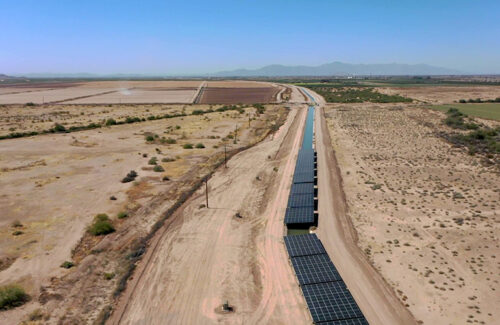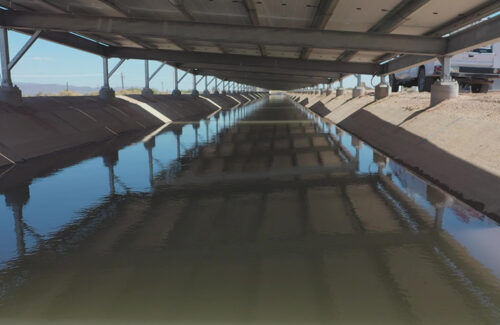A solar array built over an Arizona canal last October made history as the first project of its kind completed in the United States. This 1.3-MW solar project was erected over a 3,000-ft stretch of canalway in Casa Blanca, a community just south of Phoenix within the Gila River Indian Reservation.

The GRIC solar canal project stretches 3,000 ft — over half a mile.
Planning and construction of this project engaged indigenous labor and community groups, as well as minority-owned businesses, and the generated solar electricity is directly serving the Gila River Indian Community (GRIC). Miami Wiipica, a contractor member of the Miami Tribe of Oklahoma, assisted with the project’s construction, along with Straight Arrow Contracting of Goodyear and Industrial Solar Consulting (No. 283 on the 2025 Top Solar Contractors List) of Gilbert.
Fernando Vigil, president and solar PV design systems engineer at ISC, founded the company in 2010 after focusing on off-grid setups at Kyocera Solar. ISC’s earliest projects were building solar-powered surveillance systems for the military before shifting to PV telecommunications systems and settling into rural electrification projects.
ISC has worked with Straight Arrow on many solar projects over the last six years and was hired for the GRIC canal project through its recommendation.
“We’re trying to use our knowledge in the off-grid space to help marginalized communities and Tribal nations that don’t have access to electricity,” Vigil said. “We’re working with a lot of tribal entities and trying to make sure that they have the energy sovereignty that they need and that they deserve.”
GRIC has resided on this land and tended to it for generations, relying on water flowing from nearby canals, especially for agricultural purposes. But Arizona is in the midst of a yearslong drought, and 2024 was Earth’s hottest summer on record, causing higher levels of evaporation. Canal solar projects have been proposed as solutions to reduce evaporation in these waterways that are critical to western communities.
This custom-built array spans the width of the canal, and its foundations were mounted to concrete columns placed along the waterway. For five months, the array was assembled in sections to better follow the winding path of the canal. Installers placed these sections on ballast blocks and worked underneath, pre-wiring the electrical components before they were hoisted by a crane and placed on racking.

In addition to generating solar electricity, projects covering canals reduce evaporation on critical waterways.
The Casa Blanca Canal project is providing power to the Pee Posh and Akimel O’otham tribes that compose GRIC, and the community intends to increase its solar output over the waterway. The impact of this canal canopy project will be studied over five years — tracking evaporation, algae growth and the water’s effects on steel — and GRIC hopes to one day cover more than 18 miles of canal with solar.
This first project received $5.65 million in funding from the Inflation Reduction Act, but similar subsidies may soon be rescinded in budget reconciliation. Regardless, GRIC is committed to renewables and is already planning to start construction on a floating solar array this September.
Just north of Casa Blanca is the Gila River, a waterway that was once the local Tribes’ source of water for agriculture that dried as settlers developed the region. They diverted water and built canals to continue growing crops in the Sonoran Desert. In 2024, GRIC completed the first canal solar project in the Western Hemisphere with help from an indigenous workforce and minority-owned businesses, like ISC.
“We’re really fortunate to be able to do this and have this be something that’s going to be beneficial for that community,” Vigil said. “It’s really what we want to be doing as a minority-owned small business — growing up in areas that are lower-income and being able to support families that are being left behind. There’s so many people just in the Four Corners area that don’t have access to electricity. That’s what we’re really focused on, trying to fill the gap the best we can to help those to overcome these inequities that we’re seeing — these generational, systemic inequities.”
This story was featured exclusively in our 2025 Top Solar Contractors issue. See the issue and full list of top U.S. solar installers here.

